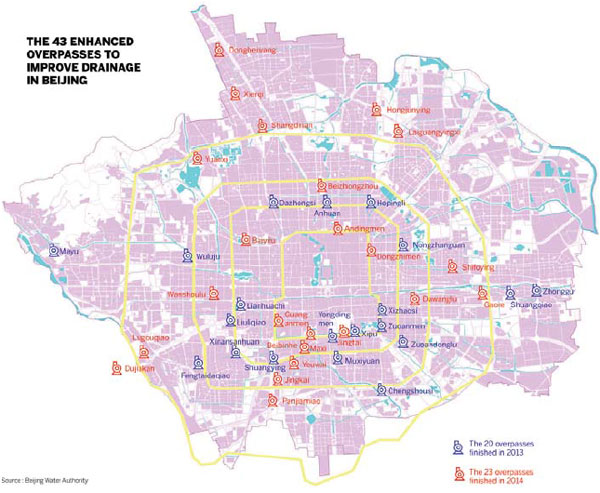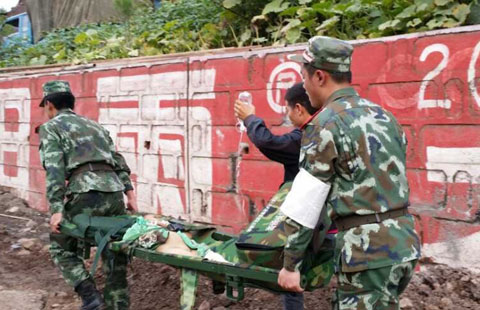City spends $580m on flood protection
Updated: 2014-08-04 07:32
By Zheng Jinran (China Daily)
|
||||||||
Beijing has allocated 3.5 billion yuan ($580 million) to improve drainage on 43 major overpasses in areas prone to flooding.
However experts say that in addition to these improvements, the capital needs to incorporate the underground drainage system into an integrated urban development plan to protect residents during the flooding season.
Lianhua Bridge on the Third Ring Road required the most complex improvement plan.
The Beijing Drainage Group, which is responsible for the work, has built a new pumping station to increase capacity and provided another 180 pipes and four storage ponds that can hold more than 11,000 cubic meters of water.
"If the pipes cannot drain the rain away quickly enough the ponds will take the rest, leaving no water on the roads," said the official in charge of the project, who declined to be named.
Li Qingmin, who lives nearby, has witnessed the improvements the works have brought.
"It was impossible to drive through the roads because the water always pooled after it rained," the 43-year-old driving instructor said. In 2011, his car broke down when it was engulfed by water as he drove under the bridge.
But this year he has seen no pools of water since the start of the rainy season in June.
The capital has taken measures to improve its flood control since a rainstorm in July 2012 led to the deaths of 79 people.
The Beijing government allocated 1.9 billion yuan last year to improve the 20 major overpasses inside the Third Ring Road, building enlarged pumping stations and storage ponds and renewing drainage pipes. As a result there were no dangerous buildups of water at any of the sites in 2013, according to the Beijing Water Authority.
This year, an extra 1.6 billion yuan has been allocated to improve another 23 overpasses, the authority said, adding that altogether 84 overpasses downtown will be upgraded in a three-year program due to be completed in 2016.
Around 55,000 safety nets have been installed beneath sewer manholes to catch pedestrians who fall in if rain washes away the covers.
"The underground drainage system should be developed under an integrated urban plan," said Yang Hongshan, a professor of urban planning at Renmin University of China.
"There should be a single body to manage the underground pipelines for municipal services such as water, gas and drainage."
Qiao Jianping, chief engineer at the Shenzhen Urban Planning and Design Institute, said the development of an integrated underground pipeline plan is important not only for Beijing but also for other cities.
Other major cities have experienced frequent flooding in their downtown areas. Shenzhen in Guangdong province was badly hit on May 11 when 2,500 roads became inundated.
Qiao said officials should consider coordinating the management of sewage systems across regions, upgrading outdated pipelines in rural areas to protect cities during the flooding season.
zhengjinran@chinadaily.com.cn


Most Viewed
Editor's Picks

|

|

|

|

|

|
Today's Top News
US ready to help China in quake relief
Xinjiang offers cash rewards for those hunting terrorists
373 dead as strong quake jolts SW China
Xi:save people's lives first after quake
69 dead, 150 injured in E China factory blast
Ebola-stricken American arrives in U.S. for treatment
Obama hosts Africa summit with an eye on legacy
'Military drill isn't targeting any nation'
US Weekly

|

|














